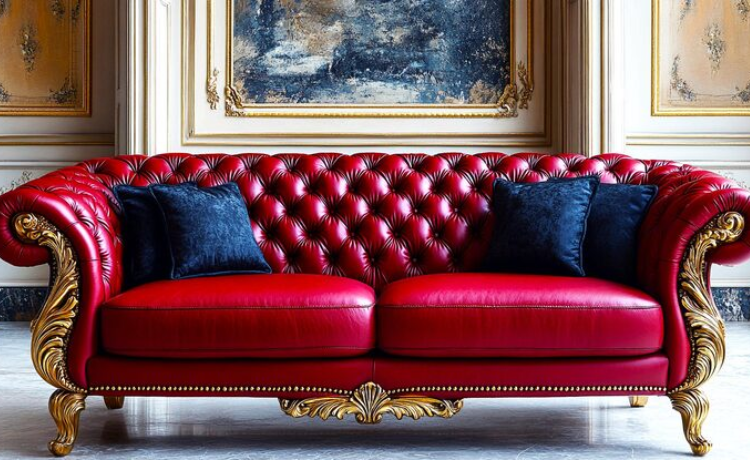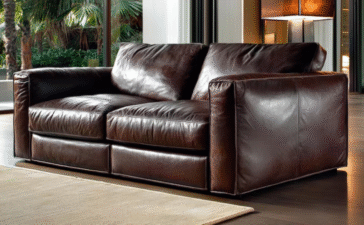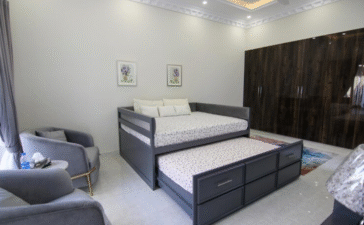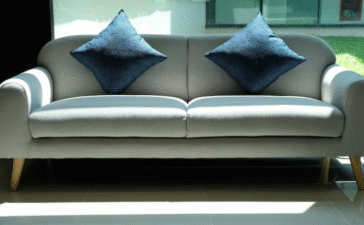The Art Deco movement emerged during the roaring twenties, a time when design celebrated progress, luxury, and bold geometry. Nearly a century later, Art Deco sofas continue to captivate homeowners and interior designers who appreciate the marriage of sophistication and striking visual appeal. These pieces aren’t merely furniture; they’re sculptural statements that anchor a room with elegance and character.
If you’re considering adding an Art Deco sofa to your living space, you’re embracing a design philosophy rooted in glamour and craftsmanship. This guide will walk you through everything you need to know about Art Deco sofas: their defining characteristics, how to select the perfect piece for your home, current trends in 2025, and where to find quality options. Whether you’re furnishing a penthouse or updating a cozy apartment, understanding these timeless pieces will help you make an informed choice that elevates your interior design.
What is an Art Deco Sofa?
Art Deco design flourished between the 1920s and 1930s, originating in France before spreading across Europe and the United States. The style represented a departure from the ornate, flowing lines of Art Nouveau, instead embracing geometric precision, symmetry, and industrial-age materials. Art Deco celebrated modernity while maintaining an air of opulence, making it the aesthetic of choice for grand hotels, ocean liners, and the homes of the affluent.
An Art Deco sofa embodies these principles through clean lines, bold geometric patterns, and luxurious materials. You’ll recognize these pieces by their angular silhouettes, stepped forms, and symmetrical compositions. Unlike sofas from other periods that may feature curves or ornamental carvings, Art Deco designs favor sharp edges and structured profiles. Materials like polished chrome, lacquered wood, and sumptuous fabrics such as velvet or leather are hallmarks of authentic Art Deco furniture.
The modern Art Deco sofa takes these classic elements and adapts them for contemporary living. Today’s manufacturers honor the original aesthetic while incorporating improved comfort features and durable construction methods. This blend of historical design with modern functionality explains why Art Deco sofas remain relevant nearly a century after their inception.
Key Features of an Art Deco Sofa
Geometric Shapes and Symmetry
Geometry lies at the heart of Art Deco design. These sofas showcase straight lines, angular forms, and symmetrical arrangements that create visual harmony. You might notice stepped armrests that resemble skyscraper silhouettes, rectangular cushions with precise proportions, or trapezoidal backs that add architectural interest.
Symmetry was paramount to Art Deco designers who believed balance created a sense of order and sophistication. When you place an Art Deco sofa in a room, its symmetrical design naturally becomes a focal point that grounds the space. The geometric patterns extend beyond the sofa’s overall shape to include fabric choices featuring zigzags, chevrons, sunburst motifs, and stylized florals rendered in angular forms.
This emphasis on geometry wasn’t merely aesthetic. The straight lines and structured forms made Art Deco furniture more suitable for mass production, aligning with the era’s celebration of industrial progress. Today, these geometric elements give Art Deco sofas a distinctive appearance that sets them apart from sofas in other styles.
Luxurious Materials
Art Deco emerged during an era of prosperity, and the furniture reflected this affluence through material choices. Velvet became synonymous with Art Deco sofas, offering a plush texture and light-catching surface that enhanced the glamorous aesthetic. Deep pile velvets in jewel tones created visual depth while providing comfortable seating.
Leather was another popular choice, particularly in deeper shades like burgundy, forest green, or classic black. High-quality leather ages beautifully, developing a patina that adds character over time. The smooth, polished surface of leather complemented the sleek lines of Art Deco design.
Beyond upholstery, Art Deco sofas incorporated exotic woods like ebony, zebrawood, and mahogany, often lacquered to a high shine. Metal accents in chrome, brass, or nickel added industrial elegance. Some designs featured inlays of mother-of-pearl, shagreen, or even semi-precious stones, demonstrating the era’s appetite for luxury and craftsmanship.
Contemporary Art Deco sofas maintain these material standards while incorporating modern fabrics that offer improved stain resistance and durability. You can find performance velvets that mimic the look and feel of traditional velvet while standing up better to daily use, making these sofas more practical for families.
Bold, Rich Colors
Color played a defining role in Art Deco design, with designers favoring dramatic, saturated hues that made powerful statements. Jewel tones dominated the palette: emerald green, sapphire blue, ruby red, and amethyst purple created rooms that felt opulent and theatrical. These colors were often paired with metallic accents in gold, silver, or bronze that caught and reflected light.
Black served as a sophisticated neutral, frequently combined with white or cream to create high-contrast schemes. This monochromatic approach emphasized the geometric lines and shapes that defined Art Deco furniture. Deep navy, chocolate brown, and charcoal gray offered additional neutral options that maintained the style’s sense of luxury.
Research in color psychology supports the emotional impact of these color choices. Deep blues and greens promote feelings of calm and stability, while warm reds and golds create energy and excitement. The saturated nature of Art Deco colors triggers stronger emotional responses than pastels or muted tones, which explains why these sofas command attention in any room.
When selecting colors for your Art Deco sofa, consider how the shade will interact with your existing decor. A jewel-toned sofa can serve as the room’s statement piece, or you might choose a neutral option and introduce bold colors through accessories and artwork.
How to Choose the Right Art Deco Sofa for Your Living Room
Room Size and Layout
Your room’s dimensions should guide your sofa selection. In smaller spaces, a compact Art Deco loveseat or two-seater maintains the style’s elegance without overwhelming the room. Look for pieces with exposed legs that create visual lightness, making the space feel more open. Apartments and condos benefit from sofas with lower backs that don’t block sightlines or make ceilings appear lower.
Larger living rooms can accommodate grander pieces, including three-seater sofas or sectionals with Art Deco styling. These rooms offer flexibility in placement. You might position the sofa to create distinct conversation areas or use it to define zones in an open-concept layout. The symmetrical nature of Art Deco design works particularly well in formal living rooms where the sofa can anchor the space between matching side tables or lamps.
Consider traffic flow when positioning your Art Deco sofa. These pieces often feature angular forms and defined edges that require adequate clearance. Ensure at least 18 inches of walking space around the sofa, and avoid placing it where the sharp corners might create obstacles in high-traffic areas.
The sofa’s orientation matters for both functionality and aesthetics. Placing an Art Deco sofa against a wall emphasizes its architectural qualities, while floating it in the room creates a more casual arrangement. Pair your sofa with complementary furniture pieces that respect the same principles of symmetry and proportion.
Choosing the Right Fabric and Upholstery
Fabric selection affects both the sofa’s appearance and its practical performance. Velvet remains the quintessential Art Deco fabric, but different velvet types serve different needs. Cotton velvet offers breathability and a soft hand but shows wear more quickly than synthetic alternatives. Polyester or blended velvets provide superior durability and stain resistance, making them suitable for households with children or pets.
Leather upholstery delivers timeless elegance and improves with age. Full-grain leather, the highest quality available, develops a rich patina over years of use. Top-grain leather costs less while still offering durability and a refined appearance. For those seeking animal-friendly options, high-quality faux leather has advanced significantly and can closely mimic genuine leather’s look and texture.
Satin and silk were popular in original Art Deco furniture but require more delicate care. Modern performance fabrics can achieve similar visual effects with improved durability. These engineered textiles resist fading, staining, and wear while maintaining the luxurious appearance associated with Art Deco design.
Consider maintenance requirements when selecting upholstery. Velvet requires regular vacuuming and occasional professional cleaning to maintain its appearance. Leather needs periodic conditioning to prevent cracking. Performance fabrics often allow for simple spot cleaning with water and mild soap. Your lifestyle should inform your choice; a pristine white velvet sofa may not suit a home with young children, while a deep navy performance velvet could work beautifully.
Mixing Art Deco with Modern Styles
Art Deco sofas integrate surprisingly well into contemporary interiors when you approach the combination thoughtfully. The geometric precision of Art Deco aligns with modern design’s emphasis on clean lines and uncluttered spaces. A velvet Art Deco sofa in a minimalist room creates an appealing contrast, adding warmth and texture to otherwise stark surroundings.
Pairing Art Deco pieces with mid-century modern furniture creates an eclectic yet cohesive look. Both styles share an appreciation for quality craftsmanship and thoughtful design, though they express these values differently. A teak credenza or Eames chair complements an Art Deco sofa’s bold presence without competing for attention.
When blending styles, maintain consistency in one or two elements while varying others. You might choose furniture pieces with different silhouettes but similar color schemes, or mix various styles while keeping materials consistent. An Art Deco velvet sofa could anchor a room that includes modern metal side tables and vintage Persian rugs, tied together through a shared color palette of navy, gold, and cream.
Avoid overwhelming your space with competing bold statements. If your Art Deco sofa features rich jewel tones and geometric patterns, balance it with simpler surrounding pieces. Conversely, a more subdued Art Deco sofa in neutral tones can accommodate busier elements elsewhere in the room.
Popular Art Deco Sofa Styles in 2025
Curved Art Deco Sofas
While angular geometry dominated early Art Deco design, the style’s later period embraced streamlined curves inspired by transportation design and aerodynamics. Curved Art Deco sofas are experiencing renewed popularity in 2025, particularly among homeowners seeking to soften modern interiors without abandoning geometric principles.
These pieces feature gentle arcs in their backs or arms, creating flowing lines that guide the eye through the room. The curves improve traffic flow around the sofa and create more intimate seating arrangements by naturally angling occupants toward each other. Design professionals note that curved sofas work particularly well in open-concept spaces where they help define areas without erecting visual barriers.
Contemporary curved Art Deco sofas often incorporate channel tufting that follows the piece’s contours, emphasizing the sculptural quality while adding textural interest. Colors tend toward softer jewel tones or sophisticated neutrals like blush pink, sage green, or dove gray that complement the gentler silhouette.
Interior designers are placing curved Art Deco sofas in conversation areas, breakfast nooks, and even primary bedrooms where they serve as elegant seating options. The versatility of these pieces makes them valuable investments that can transition between rooms as your needs change.
Vintage and Reproduction Art Deco Sofas
The market for authentic vintage Art Deco furniture remains robust, with collectors and enthusiasts seeking pieces from the style’s heyday. Original Art Deco sofas from the 1920s and 1930s offer historical significance and often feature craftsmanship difficult to replicate today. These pieces can serve as investment furniture that appreciates in value while providing functional beauty.
However, vintage Art Deco sofas present challenges. Finding pieces in excellent condition requires patience and often significant financial investment. Authentic sofas may need restoration, adding to the total cost. The original construction may not meet modern comfort standards, and vintage pieces might lack the support features today’s users expect.
Reproduction Art Deco sofas offer an alternative that honors the style while incorporating contemporary comfort and construction. Quality reproductions are crafted by skilled artisans who study historical designs and use traditional techniques alongside modern improvements. These pieces capture the aesthetic essence of Art Deco while offering better durability and ergonomic support.
When considering reproductions, research the manufacturer’s reputation and examine construction details. Quality reproductions use hardwood frames, eight-way hand-tied springs, and premium upholstery materials. They should accurately reflect Art Deco design principles rather than merely approximating the style’s surface elements.
The choice between vintage and reproduction depends on your priorities. Collectors and those furnishing historically significant properties may prefer authentic pieces despite their challenges. For most homeowners, well-crafted reproductions provide the Art Deco aesthetic with practical advantages that suit modern living.
Art Deco Sofas for Different Living Room Themes
Art Deco Sofas for Minimalist Living Rooms
Minimalism and Art Deco may seem incompatible at first glance, but they share core principles that create striking combinations. Both styles value quality over quantity, emphasizing carefully chosen pieces that make deliberate statements. A single Art Deco sofa can serve as the focal point in a minimalist room, providing visual interest without cluttering the space.
Choose Art Deco sofas with cleaner lines and less ornamentation for minimalist settings. Pieces upholstered in solid colors rather than patterns maintain the uncluttered aesthetic while introducing the luxury and sophistication associated with Art Deco design. Neutrals like charcoal, navy, or taupe work particularly well, offering depth without overwhelming the space.
The geometric precision of Art Deco furniture complements minimalism’s emphasis on form and structure. A streamlined Art Deco sofa with chrome accents pairs beautifully with minimalist elements like concrete flooring, white walls, and simple lighting fixtures. The sofa’s luxurious materials add warmth and texture that prevent minimalist spaces from feeling cold or institutional.
Keep accessories minimal when incorporating an Art Deco sofa into this aesthetic. One or two carefully selected pieces, such as a geometric sculpture or a single statement lamp, allow the sofa to shine. Resist the temptation to fill every surface, instead letting negative space balance the sofa’s visual weight.
Art Deco Sofas for Luxurious Spaces
Art Deco design originated as an expression of luxury and sophistication, making these sofas natural choices for opulent interiors. Creating a luxurious space around an Art Deco sofa requires attention to complementary elements that enhance rather than compete with the piece’s inherent glamour.
Layer textures to build visual richness. Pair a velvet Art Deco sofa with silk draperies, a plush area rug, and metallic accent pieces. The varied textures catch light differently throughout the day, creating depth and interest. Metallic finishes in gold, brass, or bronze echo the glamorous aesthetic of the Jazz Age while adding reflective surfaces that make spaces feel more expansive.
Lighting plays a crucial role in luxurious interiors featuring Art Deco furniture. Consider statement fixtures like a geometric chandelier or sculptural floor lamps that complement the sofa’s design language. Layered lighting with ambient, task, and accent sources allows you to adjust the mood while highlighting the sofa’s best features.
Color schemes in luxurious Art Deco rooms often feature rich, saturated hues balanced with metallic accents and neutral backgrounds. A ruby red velvet sofa might anchor a room with cream walls, gold-framed mirrors, and black lacquered furniture. This combination creates the Hollywood Regency glamour associated with Old Hollywood interiors.
Don’t neglect the smaller details that contribute to a luxurious atmosphere. High-quality throw pillows in complementary fabrics, coffee table books with beautiful covers, and fresh flowers add finishing touches that complete the sophisticated aesthetic.
Where to Buy an Art Deco Sofa
Trusted Art Deco Sofa Retailers
Finding a quality Art Deco sofa requires knowing where to look. Several retailers specialize in furniture that honors historical design movements while meeting contemporary standards for comfort and construction.
High-end furniture retailers often carry Art Deco-inspired pieces crafted by established manufacturers. These stores provide the advantage of seeing and testing furniture in person before purchasing. Sales staff can offer guidance on customization options, delivery logistics, and warranty coverage. Expect to pay premium prices that reflect quality materials and construction, with most Art Deco sofas ranging from $2,000 to $8,000 or more depending on size and specifications.
Online furniture retailers have expanded their Art Deco offerings in recent years, providing access to styles that might not be available locally. Sites specializing in mid-century and vintage-inspired furniture often include Art Deco pieces. Online shopping offers convenience and sometimes lower prices due to reduced overhead, but you sacrifice the ability to experience the furniture physically before committing.
Antique dealers and vintage furniture specialists can connect you with authentic Art Deco pieces, though availability varies by location. These sources require more expertise to navigate, as you’ll need to assess condition, authenticity, and fair pricing. Building relationships with reputable dealers can lead to notifications when pieces matching your criteria become available.
Custom furniture makers offer another option, particularly if you’re seeking specific dimensions or design details. Skilled craftspeople can create Art Deco sofas tailored to your space and preferences. Custom pieces typically require longer lead times and higher investment but result in furniture that perfectly meets your needs.
When evaluating retailers, research customer reviews, return policies, and warranty terms. Quality manufacturers typically offer warranties covering frame construction and springs, demonstrating confidence in their craftsmanship. Be wary of retailers offering suspiciously low prices, as these often indicate compromised quality in materials or construction.
Also Read: “traditional sofa“
Transform Your Space with Timeless Elegance
Art Deco sofas represent more than furniture; they’re connections to a design movement that celebrated progress, craftsmanship, and bold aesthetics. These pieces bring historical significance and contemporary relevance to modern interiors, serving as functional art that enhances daily living.
Whether you choose a vintage treasure or a quality reproduction, a jewel-toned velvet statement piece or a neutral leather option, your Art Deco sofa will anchor your living space with sophistication and style. The geometric precision, luxurious materials, and bold visual presence that define these sofas have endured for nearly a century because they speak to our appreciation for beauty and quality.
Take time to consider your space, lifestyle, and aesthetic preferences as you explore Art Deco sofa options. Measure carefully, test comfort levels, examine construction quality, and select materials that will serve you well over years of use. The right Art Deco sofa becomes a treasured piece you’ll enjoy for decades, possibly passing down to future generations who appreciate timeless design.
Start your search today by visiting reputable furniture retailers, both online and in person, to experience the variety of Art Deco sofas available. Your perfect piece is waiting to transform your living room into a space that celebrates the enduring appeal of this iconic design movement.
Frequently Asked Questions
What makes a sofa Art Deco style?
An Art Deco sofa features geometric shapes, symmetrical design, and luxurious materials like velvet or leather. These pieces showcase clean lines, angular forms, and often include metallic accents in chrome or brass. The style emphasizes bold colors, particularly jewel tones, and reflects the 1920s-1930s aesthetic that celebrated modernity and glamour.
Are Art Deco sofas comfortable for everyday use?
Modern Art Deco sofas incorporate contemporary comfort features while maintaining the style’s aesthetic principles. Quality pieces include high-density foam cushioning, proper back support, and ergonomic design that makes them suitable for daily use. Vintage pieces may require reupholstering or cushion updates to meet current comfort standards.
How do I maintain and clean an Art Deco velvet sofa?
Velvet Art Deco sofas require regular vacuuming with an upholstery attachment to remove dust and prevent dirt from settling into fibers. Address spills immediately by blotting rather than rubbing. For deeper cleaning, consult professional upholstery cleaners familiar with velvet care. Some modern performance velvets allow for spot cleaning with water and mild soap.
Can Art Deco sofas work in small apartments?
Art Deco sofas adapt well to smaller spaces when you choose appropriately scaled pieces. Loveseats and compact two-seater designs maintain the style’s elegance without overwhelming limited square footage. Look for sofas with exposed legs and lower backs that create visual lightness and make rooms feel more spacious.
What colors work best for Art Deco sofas?
Traditional Art Deco sofas feature jewel tones like emerald green, sapphire blue, and ruby red, often paired with metallic accents. Sophisticated neutrals including navy, charcoal, and cream also work beautifully. Your color choice should complement your existing decor while creating the desired atmosphere, whether bold and dramatic or refined and subtle.
How much should I expect to pay for a quality Art Deco sofa?
Quality Art Deco sofas typically range from $2,000 to $8,000, depending on size, materials, and whether you choose vintage or reproduction pieces. Authentic vintage sofas from the 1920s-1930s may cost more, particularly rare or designer pieces. Custom-made options can exceed these ranges but provide furniture tailored to your exact specifications.
What’s the difference between Art Deco and Art Nouveau sofas?
Art Nouveau sofas feature flowing, organic lines inspired by nature, with curved forms and ornamental details. Art Deco sofas emphasize geometric precision, straight lines, and symmetrical composition. While both styles value craftsmanship and luxury, Art Deco reflects the modern, industrial aesthetic of the 1920s-1930s rather than Art Nouveau’s naturalistic approach.
Can I mix Art Deco sofas with modern furniture?
Art Deco sofas integrate successfully with modern furniture when you maintain consistency in one or two design elements. Both styles appreciate clean lines and quality materials, making them compatible. Balance a bold Art Deco sofa with simpler modern pieces, or use a neutral Art Deco sofa as a sophisticated anchor for more varied contemporary furniture.
Where can I find authentic vintage Art Deco sofas?
Authentic vintage Art Deco sofas appear at specialized antique dealers, estate sales, auction houses, and online vintage furniture marketplaces. Building relationships with reputable dealers increases your chances of finding quality pieces. Be prepared to invest time searching and potentially arrange for restoration to bring vintage sofas to optimal condition.
What frame materials should I look for in an Art Deco sofa?
Quality Art Deco sofas feature hardwood frames, typically made from kiln-dried maple, oak, or beech. These woods provide strength and durability while resisting warping. Avoid sofas with particleboard or plywood frames, which compromise longevity. Premium pieces often include eight-way hand-tied springs for superior support and comfort that lasts decades.












